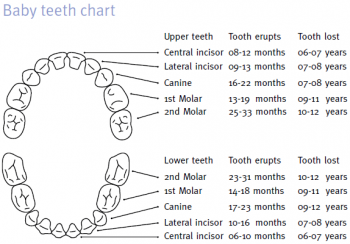Baby teething chart
Teething usually starts when your baby is about 6 months old, but you shouldn’t be surprised if the process starts anywhere between 3 and 12 months of age. During the teething process, your baby will develop 20 primary or milk teeth. These baby teeth are then replaced throughout childhood with permanent teeth, and this process usually finishes around 21 years of age.
When baby teeth start appearing, they do so in a particular order. It may take more or less time for the teeth to develop or to shed, but the order of appearance is generally the same. Most often teeth erupt in pairs and lower teeth usually develop before the upper teeth. Take a look at the chart below to get to know the teething process better.
Baby teeth development chart
| Teeth | Time of appearance | Time of falling out |
|---|---|---|
| Lower central incisor | 6-10 months | 6-7 years |
| Upper central incisor | 8-12 months | 6-7 years |
| Upper lateral incisor | 9-13 months | 7-8 years |
| Lower lateral incisor | 10-16 months | 7-8 years |
| Upper first molar | 13-19 months | 9-11 years |
| Lower first molar | 14-18 months | 9-11 years |
| Upper canine | 16-22 months | 10-12 years |
| Lower canine | 17-23 months | 9-12 years |
| Lower second molar | 23-31 months | 10-12 years |
| Upper second molar | 25-33 months | 10-12 years |
Permanent teeth development chart
| Teeth | Time of appearance |
|---|---|
| Lower central incisor | 6-7 years |
| Upper central incisor | 7-8 years |
| Lower lateral incisor | 7-8 years |
| Upper lateral incisor | 8-9 years |
| Upper first molar | 6-7 years |
| Lower first molar | 6-7 years |
| Lower canine | 9-10 years |
| Upper first premolar | 10-11 years |
| Lower first premolar | 10-12 years |
| Upper second premolar | 10-12 years |
| Lower second premolar | 11-12 years |
| Upper canine | 11-12 years |
| Lower second molar | 11-13 years |
| Upper second molar | 12-13 years |
| Upper third molar | 17-21 years |
| Lower third molar | 17-21 years |
It is very important to develop proper oral hygiene early on, so that your child can accept and maintain good habits later on. Giving a healthy start to permanent teeth and promoting the development of clear speech is a really important development milestone. Missing or decayed teeth can also be a cause of discomfort for children, and can lead to rejecting food.


